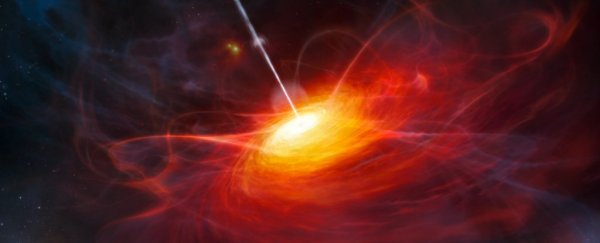What if we have quantum entanglement's 'spooky' nature all wrong, and we're missing something?
A new experiment using the wavelength of photons created more than 7.8 billion years ago makes that more unlikely than ever. If there's a classical physics explanation for the phenomenon, it's extremely well hidden.
MIT physicists have pushed the limits on an experiment they conducted last year that used light from a nearby star. This time they used photons from much further away, ones that started their journey long before our own Sun set blazing.
Entanglement is weird. There's no doubting that. It's so weird, brilliant minds like Einstein's couldn't accept it at face value, leading them to dismiss it as 'spooky'. Something else had to be at work.
And who could blame them? The phenomenon relies on a mind-boggling idea – particles don't have clearly defined properties until they interact with the apparatus that measures them.
Momentum, spin, position … these only make sense when we look hard enough at the particle. Before then, they're not 'real', at least not in an everyday sense.
So what if two particles have their properties entwined in some way, such as when they form together? Einstein figured you could measure one particle and immediately know something 'real' about the other. Dust hands, walk away.
The answer still blows our minds today. The moment one is measured, the other one – no matter where it is in the Universe – goes from being a blur of possibility to having a set measurement as well.
It's almost as if you buy a pair of shoes, but they're not real until you get home and open the shoe box. Noticing you've only got the left one, the one you left behind spontaneously turns from a 'maybe right or left' into a 'definitely right'.
In the 1960s, an Irish physicist named John Stewart Bell came up with a set of proofs showing either quantum mechanics is wrong – which isn't likely – or it's correct, and there are indeed no hidden laws operating behind the scenes that could explain this strangeness.
Bell's theorem still leaves some possible explanations, including the slim chance we're wrong about quantum mechanics. But physicists are slowly ruling them out one by one.
One persistent option is the "freedom-of-choice" loophole. Maybe when we decide what to measure in a particle, there's some knock-on effect that just creates an illusion of a correlation between particle properties?
If you sit in the shoe shop and lift your left foot, the cosmic shopkeeper behind the counter might notice and grab out a left shoe for you while holding onto the right one. Sure it's a cheat, but it's still classical physics, meaning the Universe would operate under the guidance of that familiar light-speed message service rather than something weirder.
Creating pairs of photons and then deciding exactly what to measure in a laboratory leaves plenty of room for a classical physics equivalent of the shopkeeper to create the illusion of a mysterious correlation.
But putting some distance between the choice of measurement and the actual measurement process would make it harder for those choices to be limited by a non-spooky knock-on-effect.
Last year, it was six centuries of distance, as the MIT team used the light from a nearby star to serve as a cosmic coin flip in deciding what to measure in an entanglement experiment.
This time the team turned their sights onto a pair of quasars – the energetic cores of distant galaxies. Light from one was emitted 12.2 billion years ago. Light from the other set course some 7.8 billion years ago.
A pair of telescopes took a peek at the colours of each and used them to decide how to measure the polarisation of each photon in a pair that had been entangled in a separate laboratory.
In two trials, the team found correlations between 30,000 pairs of photons, which goes far beyond what Bell calculated was necessary for the freedom-of-choice explanation.
That huge gap of time and space between coin flip and measurement leaves very little opportunity for some behind-the-scenes flim-flam to affect the experiment's measurement conditions.
How big? The chance that there's still a classical explanation is now one part in one hundred billion billion.
"If some conspiracy is happening to simulate quantum mechanics by a mechanism that is actually classical, that mechanism would have had to begin its operations – somehow knowing exactly when, where, and how this experiment was going to be done – at least 7.8 billion years ago," says the study's co-author Alan Guth.
This research was published in Physical Review Letters.
